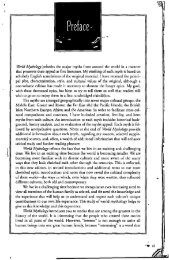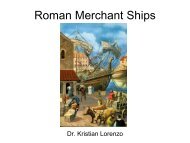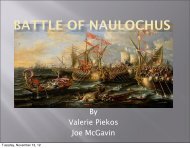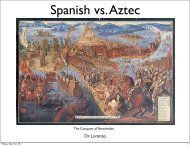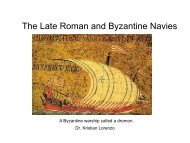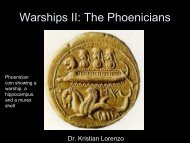9-6-2013-Etruscans-II-SomeSourcesArchofRome - Emmaf.org
9-6-2013-Etruscans-II-SomeSourcesArchofRome - Emmaf.org
9-6-2013-Etruscans-II-SomeSourcesArchofRome - Emmaf.org
You also want an ePaper? Increase the reach of your titles
YUMPU automatically turns print PDFs into web optimized ePapers that Google loves.
The <strong>Etruscans</strong> <strong>II</strong><br />
The Apollo of Veii, ca 500 BC.<br />
Dr. Kristian Lorenzo<br />
Friday, September 6, 13
Today’s Topics<br />
The <strong>Etruscans</strong><br />
Sculpture<br />
Bronze<br />
Terracotta<br />
Rome<br />
Some Sources for the Archaeology of Rome<br />
Friday, September 6, 13
Friday, September 6, 13<br />
The <strong>Etruscans</strong>: Bronze Sculpture<br />
The wounded Chimaera of Arrezzo, early 4th cent. BC.
Etruscan Sculpture: Chimaera of Arrezzo<br />
is wounded so being shown in the middle of a battle with the Greek hero<br />
Bellerophon, early 4th cent. BC. Inscribed with the word “tinscvil” =<br />
“devoted to the gods” on its right front leg.<br />
Friday, September 6, 13
Etruscan Sculpture: Chimaera of Arrezzo<br />
The wounded Chimaera of Arrezzo, early 4th cent. BC. Inscribed with<br />
the word “tinscvil” = “devoted to the gods” on its right front leg.<br />
Friday, September 6, 13
Greek Mythological Inspiration<br />
Spartan kylix (terracotta drinking cup) from ca. 565 BC showing<br />
Pegasus and the Corinthian hero Bellerophon fighting the Chimaera.<br />
Bellerophon<br />
Friday, September 6, 13
Etruscan: Bronze Sculpture<br />
The Capitoline Wolf dated to ca. 500 BC is considered a masterpiece with its<br />
combination of anatomical detail, ferocity and abstract decorative elements.<br />
Friday, September 6, 13
Etruscan: Bronze Sculpture<br />
The abstract decorative elements of the wolf’s neck can be compared to<br />
execution of the Chimaera from Arrezzo’s mane.<br />
Friday, September 6, 13
Etruscan: Bronze Sculpture<br />
However, the Capitoline Wolf only enters the historical record in 1471 when<br />
Pope Sixtus IV donated it and several other ancient bronzes to the Roman<br />
people.<br />
Friday, September 6, 13
Etruscan: Bronze Sculpture<br />
Then in the 18th-century, pioneering German art historian, Johann Joachim<br />
Winckelmann, first gave the statue an Etruscan origin, basing his attribution on the<br />
way the animal's fur was depicted and ancient accounts of similar statues.<br />
Roman<br />
authors:<br />
Cicero,<br />
Pliny the<br />
Elder<br />
Friday, September 6, 13
Friday, September 6, 13<br />
Not Etruscan: Bronze Sculpture<br />
However, even in Winkelmann’s time it was known that the babies,<br />
Romulus and Remus, were 13th century additions probably made by<br />
Florentine Old Master Antonio Pollaiolo.
Etruscan: Bronze Sculpture??<br />
In I996, art historian Anna Maria Carruba was assigned to restore the<br />
bronze. She found that it was cast in one complete piece using the lost<br />
wax method.<br />
Friday, September 6, 13
Etruscan: Bronze Sculpture<br />
The ancients also used the lost wax method to cast bronze sculptures<br />
but in pieces and then they fused them together. This method allowed<br />
them to make more elaborate pieces with no risk of total failure.<br />
The so-called Lupa of Fiesole. Hellenistic (ca. 323-30 BC)<br />
life-sized bronze statue of a lioness or she-wolf.<br />
Friday, September 6, 13
Etruscan: Bronze Sculpture??<br />
Single-piece casting was a medieval technique, used to<br />
produce objects like bells and cannons that needed a reliably<br />
rigid structure to function properly.<br />
Friday, September 6, 13
Not Etruscan: Bronze Sculpture!!<br />
Using accelerator mass spectrometry, researchers extracted, analyzed and<br />
radiocarbon dated <strong>org</strong>anic samples from the casting process. The results<br />
revealed with an accuracy of 95.4 percent that the Capitoline Wolf was crafted<br />
between the 11th and 12th century AD.<br />
Friday, September 6, 13
Etruscan: Terracotta Sculpture<br />
The Married Couple Sarcophagus from Cerveteri, late 6th cent. BC. The<br />
<strong>Etruscans</strong> invented the practice of putting figures on sarcophagus lids<br />
Friday, September 6, 13
Etruscan: Married Couple Sarcophagus<br />
The couple are lively and expressive. They are shown reclining on the marriage bed in<br />
a close seemingly loving embrace. Both have the archaic smile, and stylized features.<br />
archaic smile<br />
Friday, September 6, 13
Etruscan: Married Couple Sarcophagus<br />
The sarcophagus was for inhumations not cremations like the earlier Villanovan hut<br />
urns, or the 2nd century BC cinerary urn of Thana Plecunia Presnti Umranalisa.<br />
Friday, September 6, 13
Etruscan: Terracotta<br />
Sculpture<br />
The Apollo of Veii, ca. 500 BC<br />
striding active pose helping to impart a<br />
sense of liveliness<br />
his Etruscan “toga” is full of sharp folds<br />
arranged in patterns<br />
not fully freestanding = strut decorated<br />
with scroll pattern<br />
Friday, September 6, 13
Etruscan: Terracotta Sculpture<br />
The Apollo of Veii, ca. 500 BC set on the ridgepole<br />
of his temple, so not meant to be seen up close.<br />
archaic smile<br />
Friday, September 6, 13
Greek: Marble<br />
Sculpture<br />
The Anavysos Kouros, ca. 510 BC<br />
inspired by Egyptian large-scale sculpture<br />
naked, stiff posture<br />
anatomical details and hair more pattern<br />
and abstraction<br />
more an ideal than a real young man<br />
fully freestanding<br />
Friday, September 6, 13
Greek: Marble Sculpture<br />
The Anavysos Kouros, late 6th cent. BC, served as an inscribed grave<br />
marker and may have represented the deceased himself. Kouroi (the<br />
plural form of kouros) could also be set in sanctuaries as dedications.<br />
archaic smile<br />
“Stay and mourn at the<br />
monument for dead<br />
Kroisos whom violent<br />
Ares destroyed, fighting in<br />
the front rank.”<br />
Friday, September 6, 13
Etruscan: Terracotta Sculpture/Greek: Marble Sculpture<br />
The Apollo of Veii, ca. 500 BC<br />
The Anavysos Kouros, late 6th cent. BC<br />
Friday, September 6, 13
Rome: Sources<br />
Antiquarian and Architectural Drawings and Maps: In the 16th and 17th<br />
century many artists and architects drew the ancient buildings of Rome. Some of<br />
these buildings still exist, many do not. The drawings and maps often<br />
Etienne Du Pérac (ca.1525-1604)<br />
The Palatine Hill<br />
The Septizodium<br />
Circus Maximus<br />
Friday, September 6, 13
Rome: Marble Plan http://formaurbis.stanford.edu<br />
The Forma Urbis Romae/Severan Marble Plan of Rome: in AD 203-211 an 18 x 13 m marble plan of<br />
Rome was carved and then installed on a wall of the Templum Pacis (Temple of Peace) in the city.<br />
Friday, September 6, 13
Rome: Marble Plan http://formaurbis.stanford.edu<br />
The Forma Urbis Romae/Severan Marble Plan of Rome: in AD 203-211 an 18 x 13 m marble plan of<br />
Rome was carved and then installed on a wall of the Templum Pacis (Temple of Peace) in the city.<br />
Theater of Pompey, 55 BC<br />
Circus Maximus (trad. date - Romulus)<br />
Friday, September 6, 13
Rome: Coins http://www.romancoins.info/VIC-Buildings.html<br />
Important buildings often appeared on issues of Roman coinage. The<br />
information contained on the coin must be carefully weighed due to<br />
the inherent difficulties in representing architecture in such a small<br />
medium. Temple of Vesta, AD 79<br />
Remains of the Temple of Vesta<br />
Friday, September 6, 13
Rome: Coins http://www.romancoins.info/VIC-Buildings.html<br />
Important buildings often appeared on issues of Roman coinage. The<br />
information contained on the coin must be carefully weighed due to<br />
the inherent difficulties in representing architecture in such a small<br />
medium.<br />
Temple of Vesta, 56 BC<br />
Remains of the Temple of Vesta<br />
Friday, September 6, 13
Rome: Coins http://www.romancoins.info/VIC-Buildings.html<br />
Important buildings often appeared on issues of Roman coinage. The<br />
information contained on the coin must be carefully weighed due to<br />
the inherent difficulties in representing architecture in such a small<br />
medium<br />
Shrine of<br />
Janus Geminus<br />
Friday, September 6, 13
Rome: Public Inscriptions<br />
Over 50,000 inscriptions in stone or bronze have been found in and around the city.<br />
They include dedications and other references, which can provide a great deal of info.<br />
Temple<br />
of Saturn<br />
The Senate and the Roman People<br />
restored this temple which had been destroyed by fire.<br />
Friday, September 6, 13
Rome: Private Inscriptions<br />
Marcus Vergilius Eurysaces made his fulfilling public contracts for bread in the first<br />
century BC. To house his remains he had a large inscribed tomb constructed.<br />
This monument belongs to Marcus Vergilius Eurysaces, baker and contractor.<br />
He attends...<br />
Friday, September 6, 13
Rome: Literary Sources<br />
Claridge lists (p. 34-8) 50 literary sources useful for the study of the archaeology of<br />
Rome. Many authors from poets to playwrights to historians to orators to architects<br />
and geographers wrote about or included references to Rome and its buildings.<br />
A few of the most useful include:<br />
Diodorus Siculus (Greek Historian)<br />
Livy (Roman Historian)<br />
Dionysius of Halikarnassos (Greek Historian)<br />
Virgil (Roman Poet)<br />
Tacitus (Roman Historian)<br />
Suetonius (Roman Biographer)<br />
Friday, September 6, 13





